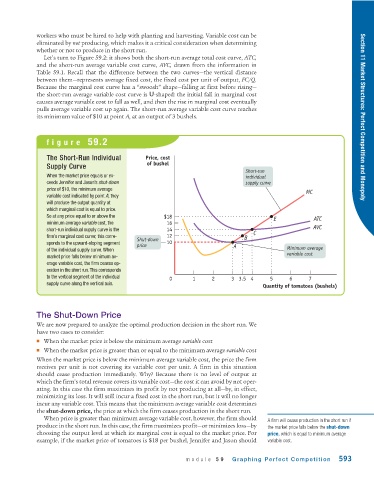Page 635 - Krugmans Economics for AP Text Book_Neat
P. 635
workers who must be hired to help with planting and harvesting. Variable cost can be
eliminated by not producing, which makes it a critical consideration when determining
whether or not to produce in the short run.
Let’s turn to Figure 59.2: it shows both the short-run average total cost curve, ATC,
and the short-run average variable cost curve, AVC, drawn from the information in
Table 59.1. Recall that the difference between the two curves—the vertical distance
between them—represents average fixed cost, the fixed cost per unit of output, FC/Q.
Because the marginal cost curve has a “swoosh” shape—falling at first before rising—
the short-run average variable cost curve is U-shaped: the initial fall in marginal cost
causes average variable cost to fall as well, and then the rise in marginal cost eventually
pulls average variable cost up again. The short-run average variable cost curve reaches
its minimum value of $10 at point A, at an output of 3 bushels. Section 11 Market Structures: Perfect Competition and Monopoly
figure 59.2
The Short-Run Individual Price, cost
of bushel
Supply Curve
Short-run
When the market price equals or ex- individual
ceeds Jennifer and Jason’s shut-down supply curve
price of $10, the minimum average MC
variable cost indicated by point A, they
will produce the output quantity at
which marginal cost is equal to price.
So at any price equal to or above the $18 ATC
minimum average variable cost, the 16 E
short-run individual supply curve is the 14 AVC
firm’s marginal cost curve; this corre- 12 B C
Shut-down
sponds to the upward-sloping segment 10
price A
of the individual supply curve. When Minimum average
variable cost
market price falls below minimum av-
erage variable cost, the firm ceases op-
eration in the short run. This corresponds
to the vertical segment of the individual 0 1 2 3 3.5 4 5 6 7
supply curve along the vertical axis.
Quantity of tomatoes (bushels)
The Shut-Down Price
We are now prepared to analyze the optimal production decision in the short run. We
have two cases to consider:
■ When the market price is below the minimum average variable cost
■ When the market price is greater than or equal to the minimum average variable cost
When the market price is below the minimum average variable cost, the price the firm
receives per unit is not covering its variable cost per unit. A firm in this situation
should cease production immediately. Why? Because there is no level of output at
which the firm’s total revenue covers its variable cost—the cost it can avoid by not oper-
ating. In this case the firm maximizes its profit by not producing at all—by, in effect,
minimizing its loss. It will still incur a fixed cost in the short run, but it will no longer
incur any variable cost. This means that the minimum average variable cost determines
the shut-down price, the price at which the firm ceases production in the short run.
When price is greater than minimum average variable cost, however, the firm should A firm will cease production in the short run if
produce in the short run. In this case, the firm maximizes profit—or minimizes loss—by the market price falls below the shut-down
choosing the output level at which its marginal cost is equal to the market price. For price, which is equal to minimum average
example, if the market price of tomatoes is $18 per bushel, Jennifer and Jason should variable cost.
module 59 Graphing Perfect Competition 593

